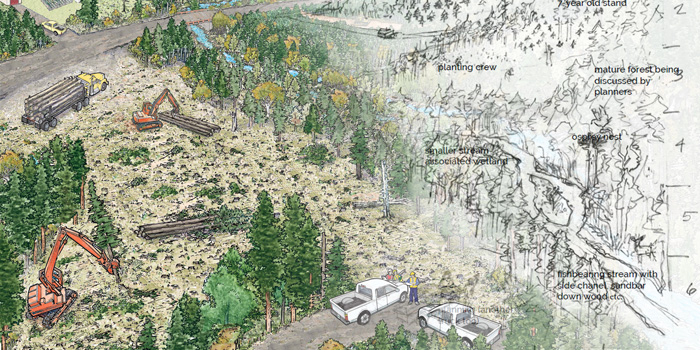The making of a manual
May 20, 2024
The much-anticipated fourth edition of Oregon’s Forest Protection Laws: An Illustrated Manual, which includes information about recent updates to state forest practice regulations, is finally here!
The OFRI-produced manual has become a standard reference for forest landowners, managers, operators and all seeking to learn about state forest practice rules and regulations, and it’s now available as a free digital download from the publication library on our website.
Producing a new edition of the manual, which OFRI first published in 2002, was necessary following major changes to the Oregon Forest Practices Act resulting from the Private Forest Accord, an agreement between the timber industry and environmental groups.
When OFRI published the first edition of the Illustrated Manual, I had just started working for the agency. I was excited to be part of a team that was putting out a book that would be a game-changer in Oregon for forest landowners and managers. OFRI’s executive director at the time was Leslie Lehmann, and Barte Starker was leading OFRI’s board of directors. They contracted with Robert Logan, who was a forestry specialist with the Montana State University Extension Service, to author the manual. My contribution to the team was going out to many county fairs, conferences, community meetings and other places people were gathering, to help get copies of the manual into the hands of those who needed them.
Since the Oregon Forest Practices Act was passed in 1971, the Oregon Department of Forestry (ODF) has enforced its rules. With more than 250 enforceable rules in the law that apply to state and private forestlands, there’s a lot to comprehend. To help Oregonians understand these rules, OFRI partnered with ODF to create the manual’s colorful illustrations that help readers visualize what they’ll need to do on the ground to ensure they’re following the law when conducting forestry operations on their property, such as logging or forest road building.
Besides offering guidance about Oregon’s forestry regulations, the Illustrated Manual helps Oregonians understand that sustainability is at the core of our state laws regarding forest practices and land use planning. This includes regulations aimed at protecting soil, water, air and wildlife habitat.
Over the past 20-plus years, OFRI has revised the manual as the Oregon Board of Forestry has updated the Forest Practices Act rules based on the latest scientific findings and the priorities of Oregonians. Last year, I was honored to lead the project team in a major revision of the entire manual. When the Private Forest Accord was finalized, we knew it would mean a major revision with many additions. You can learn more about this historic agreement in OFRI’s special report, Finding Common Ground.
What are the highlights of the fourth edition of the Illustrated Manual?
- It’s reorganized into 10 chapters by subject.
- It adds 90 pages (for a total of 250!).
- It distinguishes laws for small forestland owners (SFOs).
- It includes more than 355 photos, illustrations, diagrams, tables and charts.
- It was initially released in a digital-only format.
While the manual has undergone several changes, what has remained steady is our commitment to assembling a large team of advisors, subject matter experts, authors, illustrators and reviewers. More than 50 professionals provided their expertise to this project, and we’re incredibly grateful for all these contributions.
The newest edition of the manual is being updated in two phases. The first phase included forest practice rules that went into effect Jan. 1, and the second phase will include additional rules and protocols expected to be released later this year. OFRI made the decision to release a digital-only version in April to assist landowners with understanding the complexity of the first set of new rules.
A two-phase release also allows time for us to hear valuable feedback from the public about the new manual. The public review process for this project is open until May 24, and information about how to submit a comment is available on our website.
The second phase of the revision will integrate any updates that are still being finalized, as well as any relevant public feedback we receive. Following this phase, our goal is to print hard copies of the manual by early 2025. OFRI’s OregonForests.org website is a good place to monitor for any updates and ordering options.
We still encourage anyone who uses the manual to also reference the legal rules and requirements available on ODF’s website. We also strongly encourage seeking out technical field assistance with following the forest practice rules, such as through setting up a property visit with one of ODF’s stewardship or SFO foresters.
Enjoy the manual!
Julie Woodward
Director of Forestry
